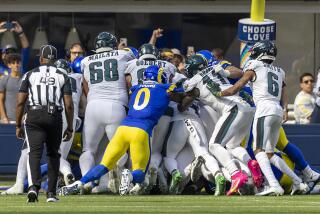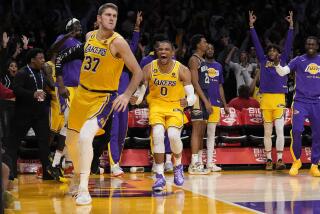LARRY BIRD : Stopping Him Is Complicated . . . and Iffy
- Share via
Larry Bird can score from every corner, from every angle, from nearly every spot on the basketball court. And if he is double- or triple-teamed, as is often the case, open teammates know they can expect the perfect pass in the blink of an eye.
So how do you plot a defense to stop the Boston Celtics’ main man?
“First, you have to realize that you can’t play him the same way every time,” said Dave Wohl, who was an assistant coach with the Los Angeles Lakers in 1984 and 1985 specifically assigned to study films in an effort to devise defenses to stop Bird in the championship series.
“The Lakers had four or five ways to do it,” Wohl continued. “If Michael Cooper was on him, we’d deny him the ball. If it was James Worthy, we’d back off him. When we had Larry Spriggs, we would try to bang him and beat him up physically.
“We wanted to bump him every time, even if it was 30 feet away from the basket, just to establish contact. Sometimes we would switch off on picks, sometimes not at all. And we’d rotate defensive styles every four or five minutes. We wanted him to have to think every time he touched the ball, ‘Before they were denying, now they’re switching.’ We wanted to get him out of rhythm, expecting something different so he’d never feel comfortable about what was coming next. I think we did a very good job against him.”
Very good obviously is a matter of perspective. In 19 playoff meetings against the Lakers, Bird has averaged more than 25 points a game.
The Detroit Pistons, the Celtics’ opponents in this season’s Eastern Conference finals, which begin Wednesday at Boston Garden, have been even less successful than Los Angeles, yielding 27.6 points per game to Bird in 13 postseason encounters.
Neither team has anything to be ashamed of. Ever since he joined the NBA in the fall of 1979, Bird has made a habit of foiling defensive schemes.
Sometimes it happens when Bird deliberately steps back behind the three-point circle to nail a long-distance jumper. Other times he’s floating through the lane to hit a high-arc shot over the arm of an onrushing opponent. More than a few times he barges toward the basket, drawing defenders toward him, only to dish off a pass to a teammate at the last second for an easy basket.
More than anything else, Bird’s ability to execute consistently all those varied facets of the game makes him so dangerous. Just ask the Atlanta Hawks, who could only watch in wonder as Bird scored 20 points in the fourth quarter to help the Celtics win Game 7 Sunday and advance to the next round.
“Larry was incredible. We played great defense and tried everything. Unfortunately, everything wasn’t enough,” said Atlanta guard Glenn Rivers after Bird made nine of 10 shots in the final period.
Added Celtics teammate Kevin McHale, “Larry got that look in his eye. When he gets a look like that, it’s Katy bar the door. ... The only way they could have stopped Larry down the stretch was to kill him.”
And Bird is abetted by veteran teammates who have become attuned to his game, particularly his fellow starters McHale, Robert Parish, Dennis Johnson and Danny Ainge. They all have played together for the better part of the last six seasons and each has been an all-star at one time or another.
Their collective talents and acumen have to be acknowledged by all of Boston’s opponents. And Bird, who is well aware of it, plays off his teammates. Defense him straight up and Bird may get 40 points at any given time. Concentrate on stopping his scoring and you may limit him to 20, but he’ll make up the difference with 10 assists.
One of the Celtics’ favorite plays starts with Bird inbounding the ball on the sideline near their basket. The first option is a simple lob pass to McHale, a 60 percent field goal shooter, standing in the low post. The natural tendency for defenses is to have the man guarding the passer cheat down low and double-team McHale.
When that happens, McHale just gives a return pass to Bird, who often can then shoot an uncontested three-pointer, the sort of shot that has allowed him to win the NBA’s long-distance shooting competition three straight years.
“He’ll coordinate them (his teammates) to a spot on the floor and then just read the defense and do whatever he needs to,” said Phil Jackson, an assistant with the Chicago Bulls. “They have a play where Ainge, Parish and Bird come together. What you want to do is jam it so that no one can move, but it invariably ends up with Bird going backdoor for a layup or getting the ball on the wing with a guard on him after a switch.”
Another of the Celtics’ offensive sets begins with Bird on the left baseline. He starts through the lane, where he gets a pick from McHale. If the defensive man fights through that pick, there’s another by Parish on the other side of the paint. Catching the ball about 12 feet from the basket, Bird can take a turnaround jumper or fake the shot and drive into the lane for a floater.
The oddest thing about the play is that when he receives the pass, Bird is moving right to left, an unnatural motion that forces him to shoot almost across his body while his momentum takes him away from the basket.
“That’s how it’s been for the six years that K.C. (Jones) has been coach,” Bird said. “That’s not how shooting was meant to be, but I sort of like it now; at least I feel more comfortable with it. In that situation, the defensive man has to follow around behind me. If he stays in the lane or goes around on the other side early, I’ll just step back, Robert’ll set a pick and I’ll have open jump shots all night.”
Jackson says the only alternative is to set the defense so that when Bird gets the ball, he’s a foot or so farther from the basket, throwing off the play’s coordination. Wohl thinks the best bet is to use players of similar size -- like the Lakers with Worthy, Cooper and Magic Johnson -- so that when a switch is made, Bird won’t have an exaggerated height advantage.
Both approaches fail to take into account Bird’s deceptive strength. Bird is 6 feet 9, 215 pounds but, said Jackson, “he’s much, much stronger than he looks.”
That’s most evident when Bird is isolated on the wing against a defender. Unlike Dominique Wilkins, who faces his man and uses a quick first step to blow by his opponent, Bird turns his back, pounding the ball into the floor and keeping the defender at bay with his hips as he steadily backs in toward the basket.
Again, the defense now has a choice to make. It can let the first defender battle one-on-one, which usually ends with Bird taking a close-in shot, or rush a second man over to double-team. When that happens, the Celtic left open immediately cuts to the basket. That often ends with a layup on a feed from Bird, who’s been scanning the floor out of the corners of his eyes the entire time.
“You want to extend him on defense and deny him the ball, but you don’t want him to take those step-back jumpers,” said Jackson. “You stay close and he gets picks and steps out and that’s a dangerous situation. When he catches the ball going to the basket, you’re in trouble, too, because he can go to the left or the right and can pass the ball both ways.
“Whatever he does, a lot of times it’s devastating.”
More to Read
Go beyond the scoreboard
Get the latest on L.A.'s teams in the daily Sports Report newsletter.
You may occasionally receive promotional content from the Los Angeles Times.










